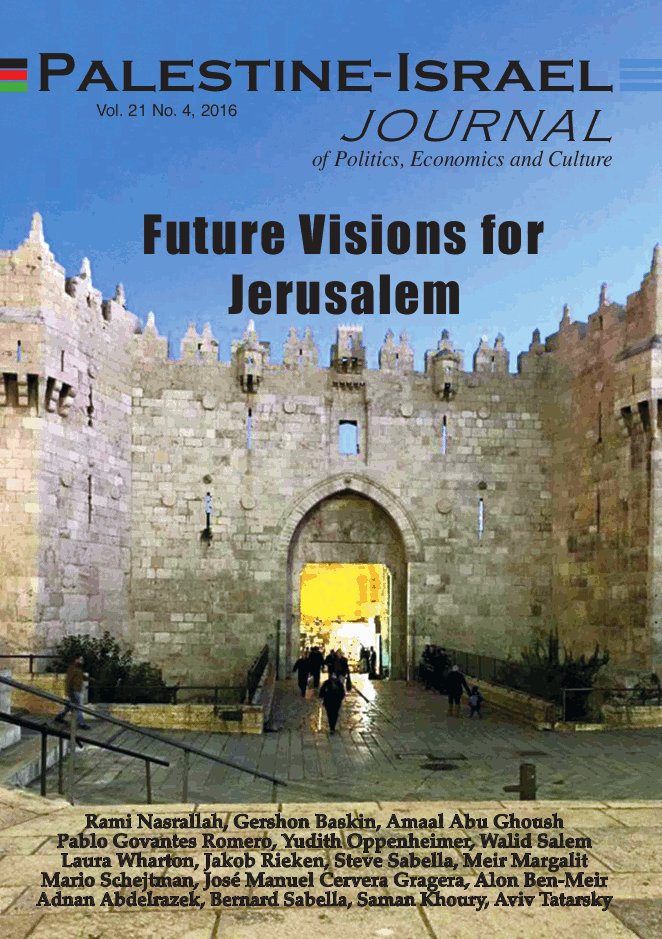During the first week of November 2016, Seville hosted a conference devoted to “Empowering East and West Jerusalem’s Younger Generation: Bridging to a Fair Political Resolution and Promoting the Role of Andalusian Society in the construction of Middle East Peace,” organized jointly by the Spanish organization Asamblea de Cooperación por la Paz (ACPP), Ir Amim from Israel and the Palestine-Israel Journal (PIJ).
The joint organization of the meeting drew upon the complementarity of initiatives being carried out by these three organizations to contribute to a peaceful resolution of the Israeli-Palestinian conflict. On one hand, PIJ and Ir Amim are immersed in a process of working with young Palestinian and Israeli activists from different social backgrounds and professional sectors to develop their capacities as future leaders — to be able to actively participate in a practical and productive dialogue at the local level to make Jerusalem a more just and liveable city for its Palestinian and Israeli citizens, and to contribute in the medium term to a future negotiated resolution of the conflict.
On the other hand, ACPP is developing initiatives aimed at promoting the active participation of Andalusian society in the quest for a just and lasting resolution of the Palestinian-Israeli conflict, strengthening the channels of dialogue between Andalusian political and social actors with their Palestinian and Israeli counterparts, raising awareness among Andalusian society and conducting advocacy directed at Andalusian, Spanish and European institutions on the decisive role that they can play in the search for peaceful solutions.
A Collective Vision of the City as a Home to All
The meeting brought together a group of young Palestinians, Israelis and Andalusians working on issues related to the physical and social space of their respective cities from different social and professional sectors, to discuss the Israeli-Palestinian conflict, focusing specifically on the urban context of Jerusalem which, as a shared and divided city, is a paradigmatic example and a nerve center in which the difficulties of coexistence are concentrated.
The dynamics of the meeting led to personal rapprochement between the groups and their members in a climate of initial cordiality that, with the passing of the days, gained dialectical and emotional intensity. Despite the opposing views, it was possible to construct a collective vision of the city as a home to all, with the common desire for a future in which there are spaces for coexistence, respect for the different peoples that inhabit the city, and freedom of movement and personal development.
The An d a l u s i a n participation added an external vision removed from the daily conflict that faces Jerusalem, contributing to the debate local approaches to coexistence. The group had the opportunity to meet with, and visit sites of positive experiences of coexistence involving social and neighborhood collectives in the center of Seville, such as the Casa Grande del Pumarejo (http:// www.pumarejo.es/).
The image of Jerusalem that the Andalusian vision offered to the Palestinian and Israeli groups enabled them to become aware of the reality of the conflict from another point of view. One of the Israeli participants commented that “when our Spanish hosts intervened in the discussion, our life was reflected through their eyes. I was struck by the image: a divided and conflicted city, plagued by violence and that does not urge either party to believe that calm and peace will be achieved soon.”
The Importance of a Neutral Third-Party Environment
The city of Seville offered a neutral environment, removed from the pressure and the social and cultural conflicts that characterize daily life in Jerusalem, serving as a space for dialogue and peaceful coexistence between the Palestinian, Israeli and Andalusian participants.
The meeting made it possible for the president of the Andalusian Parliament and representatives of the different political parties to gain a first-hand understanding of the current situation in relation to the conflict, and to renew their commitment to Andalusia’s role in contributing to its resolution from its two-fold strategic position as a bridge between the Arab world and Europe and as a key member of the Mediterranean Sea basin region.
This positive experience highlights the importance of continuing to support initiatives that enable dialogue between actors from both societies and that foster mutual understanding and cooperation. The fact that this dialogue took place on third-party territory made it possible to involve the host society in the peace-building process and to create links with local organizations, while empowering organizations and individuals who continue to work — against the odds — for a peaceful and negotiated solution of the conflict.

